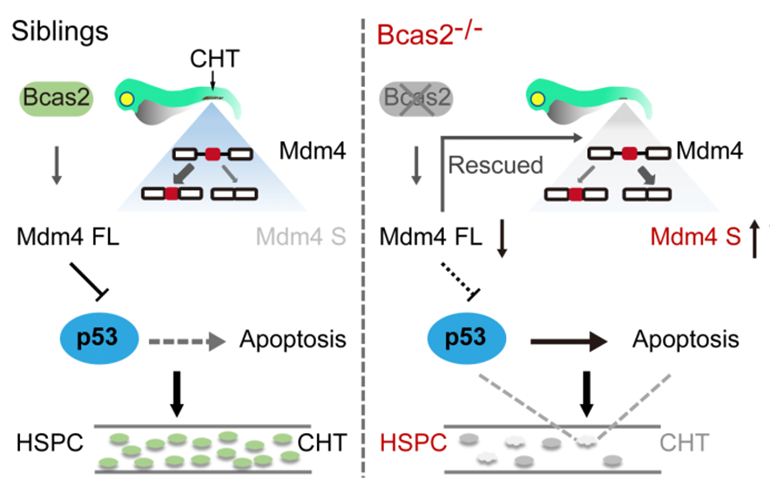News.hust.edu.cn (Press corps: Han Yunqiao Correspondent: Yu Shanshan) On February 21, the international authoritative journal of hematology Blood published the research article of professor Liu Mugen's team from the college of life science as the cover article “BCAS2 is essential for hematopoietic stem and progenitor cell maintenance during zebrafish embryogenesis” (Blood. 2019;133(8):805-815). This article revealed for the first time the regulatory mechanism of splicing factor BCAS2 in the development and differentiation of hematopoietic stem cells. The accompanying review article by professor de Jong of the university of Chicago “Splicing up hematopoietic development” (Blood 2019; 133:770-771) was accordingly published in the journal, which highly appraised the achievements of Liu Mugen’s team. Professor de Jong believed that this article would lead to the follow-up study on the mechanism of different splicing factors in hematopoiesis, and reveal the new molecular mechanism in the formation, maintenance and differentiation of hematopoietic stem cells. Further studies may also uncover more differentially splicing mRNAs that regulate HSPCs development and malignant transformation, and provide a new entry point for direct induction of HSPC differentiation or targeted treatment of hematologic tumors by small molecules or other therapeutic approaches.
Hematopoietic mechanisms are highly conserved in vertebrates. In recent years, studies at home and abroad have found that gene mutations of some splicing factors (including U2AF1, SF3B1, ZRSR2, SRSF2, etc.) were closely related to myelodysplastic syndrome (MDS), anemia and leukemia, suggesting that splicing regulation may play an important role in the development and differentiation of hematopoietic stem cells. RNA splicing is a highly synergistic process catalyzed by spliceosome. It is completed before protein translation through removing introns and combining exons of the precursor messenger RNA by spliceosome, which is one of the processes in which the precursor mRNA of eukaryotes becomes mature mRNA. Although some different splicing factor defects can cause blood-related diseases, their phenotypes are not completely the same, and the signal pathway of blood diseases caused by splicing factor defects involved in the pre-mRNA splicing process is still not clear.
BCAS2 (breast carcinoma amplified sequence 2) is an important component of the spliceosome; previous studies have found that it played an important role in regulating cell survival and development. Liu Mugen research group also found that BCAS2 played a role in maintaining the development and differentiation of the lens, but how BCAS2 regulated the hematopoietic development process in vivo has not been studied. In order to explore the physiological function of BCAS2 in vivo, Liu Mugen research group cooperated with Luo Daji, associate professor of Wuhan University, and established the BCAS2 zebrafish gene knockout model by gene editing technology. It was found that BCAS2 co-located with hematopoietic stem cells in zebrafish, and the knockout of BCAS2 resulted in a significant reduction in the formation of secondary hematopoietic stem cells in zebrafish. By analyzing the molecular mechanism of abnormal development and differentiation of hematopoietic stem cells, they found that BCAS2 mutation resulted in significantly increased expression of p53 and its downstream target gene, which further promoted apoptosis of hematopoietic stem cells. Further mechanism studies found that BCAS2 participated in the splicing of MDM4, and the knockout of BCAS2 in zebrafish resulted in the abnormal splicing of exon 6 of MDM4 gene, while the normal expression of MDM4 was down-regulated, which promoted the transcriptional activity of p53 and eventually led to the apoptosis of hematopoietic stem cells (figure 1). The results of Shanshan Yu et al showed that BCAS2, as a splicing factor, played an important role in the development and differentiation of hematopoietic stem cells.

Figure 1.BCAS2 was involved in the splicing reaction of precursor mRNA of MDM4 in hematopoietic stem cells, affecting the selection of splicing sites
Postdoctoral fellow Yu Shanshan and associate professor Jiang Tao from college of life science are joint first authors of the article, and professor Liu Mugen and associate professor Luo Daji of basic medical college of Wuhan University are co-corresponding authors. The research was funded by Natural Science Foundation of China, Independent Innovation Fund of Huazhong University of Science and Technology, and the research platform of the college of life science and technology of Huazhong University of Science and Technology.
